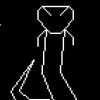What kind of game? I don't know of any tutorials, but for collision detection, it should be pretty straightforward. I'd do it with bitmasks, where each bit corresponds to one pixel of the sprite (1 for solid, 0 for non-solid). Then bitshift according to the sprites' relative X positions, AND together, and if the result is zero, no collision. Nonzero means one or more pixels overlapping. If you limit your sprites to 32 pixels wide, the collision mask can just be an array of 32-bit unsigned longs, one for each row of pixels in the sprite.
But I'd only use it for detection of collisions with bullets or other attacks, not for anything motion related. Motion is hard enough with geometric shapes, and pixel perfect might not behave well even if you did get it working (snagging pixels of the character on ledges and such)






